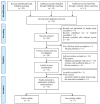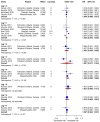Associations between Particulate Matter and Otitis Media in Children: A Meta-Analysis
- PMID: 32604870
- PMCID: PMC7345266
- DOI: 10.3390/ijerph17124604
Associations between Particulate Matter and Otitis Media in Children: A Meta-Analysis
Abstract
Particulate matter (PM), a primary component of air pollution, is a suspected risk factor for the development of otitis media (OM). However, the results of studies on the potential correlation between an increase in the concentration of PM and risk of developing OM are inconsistent. To better characterize this potential association, a meta-analysis of studies indexed in three global databases (PubMed, EMBASE, and The Cochrane Library) was conducted. These databases were systematically screened for observational studies of PM concentration and the development of OM from the time of their inception to 31 March 2020. Following these searches, 12 articles were analyzed using pooled odds ratios generated from random-effects models to test for an association between an increased concentration of PM and the risk of developing OM. The data were analyzed separately according to the size of particulate matter as PM2.5 and PM10. The pooled odds ratios for each 10 μg/m3 increase in PM2.5 and PM10 concentration were 1.032 (95% confidence interval (CI), 1.005-1.060) and 1.010 (95% CI, 1.008-1.012), respectively. Specifically, the pooled odds ratios were significant within the short-term studies (PM measured within 1 week of the development of OM), as 1.024 (95% CI, 1.008-1.040) for PM2.5 concentration and 1.010 (95% CI, 1.008-1.012) for PM10 concentration. They were significant for children under 2 years of age with pooled odds ratios of 1.426 (95% CI, 1.278-1.519) for an increase in the concentration of PM2.5. The incidence of OM was not correlated with the concentration of PM, but was correlated with an increase in the concentration of PM. In conclusion, an increase in the concentration of PM2.5 is more closely associated with the development of OM compared with an increase in the concentration of PM10; this influence is more substantial in shorter-term studies and for younger children.
Keywords: child; meta-analysis; otitis media; particulate matter.
Conflict of interest statement
The authors declare no conflict of interest.
Figures






Similar articles
-
Effects of pre-natal and post-natal exposures to air pollution on onset and recurrence of childhood otitis media.J Hazard Mater. 2023 Oct 5;459:132254. doi: 10.1016/j.jhazmat.2023.132254. Epub 2023 Aug 9. J Hazard Mater. 2023. PMID: 37572606
-
Particular matter influences the incidence of acute otitis media in children.Sci Rep. 2021 Oct 5;11(1):19730. doi: 10.1038/s41598-021-99247-3. Sci Rep. 2021. PMID: 34611241 Free PMC article.
-
Ambient particulate matter (PM1, PM2.5, PM10) and childhood pneumonia: The smaller particle, the greater short-term impact?Sci Total Environ. 2021 Jun 10;772:145509. doi: 10.1016/j.scitotenv.2021.145509. Epub 2021 Feb 1. Sci Total Environ. 2021. PMID: 33571778
-
Long-term exposure to PM and all-cause and cause-specific mortality: A systematic review and meta-analysis.Environ Int. 2020 Oct;143:105974. doi: 10.1016/j.envint.2020.105974. Epub 2020 Jul 20. Environ Int. 2020. PMID: 32703584
-
Does utilizing WHO's interim targets further reduce the risk - meta-analysis on ambient particulate matter pollution and mortality of cardiovascular diseases?Environ Pollut. 2018 Nov;242(Pt B):1299-1307. doi: 10.1016/j.envpol.2018.07.041. Epub 2018 Jul 28. Environ Pollut. 2018. PMID: 30121484 Review.
Cited by
-
Effects of Particulate Matter Exposure on the Eustachian Tube and Middle Ear Mucosa of Rats.Clin Exp Otorhinolaryngol. 2023 Aug;16(3):225-235. doi: 10.21053/ceo.2023.00227. Epub 2023 May 18. Clin Exp Otorhinolaryngol. 2023. PMID: 37202348 Free PMC article.
-
Stochastic and Self-Organisation Patterns in a 17-Year PM10 Time Series in Athens, Greece.Entropy (Basel). 2021 Mar 5;23(3):307. doi: 10.3390/e23030307. Entropy (Basel). 2021. PMID: 33807725 Free PMC article.
-
Effect of Angiogenesis and Lymphangiogenesis in Diesel Exhaust Particles Inhalation in Mouse Model of LPS Induced Acute Otitis Media.Front Cell Infect Microbiol. 2022 May 11;12:824575. doi: 10.3389/fcimb.2022.824575. eCollection 2022. Front Cell Infect Microbiol. 2022. PMID: 35646744 Free PMC article.
-
Trends in the incidence and burden of otitis media in children: a global analysis from 1990 to 2021.Eur Arch Otorhinolaryngol. 2025 Jun;282(6):2959-2970. doi: 10.1007/s00405-024-09165-z. Epub 2024 Dec 24. Eur Arch Otorhinolaryngol. 2025. PMID: 39719471 Free PMC article.
-
Effects of air pollution on emergency visits for acute otitis media among children: a case-crossover study in Chongqing, China.Front Public Health. 2023 Oct 16;11:1195660. doi: 10.3389/fpubh.2023.1195660. eCollection 2023. Front Public Health. 2023. PMID: 37908685 Free PMC article.
References
Publication types
MeSH terms
Substances
LinkOut - more resources
Full Text Sources
Medical

